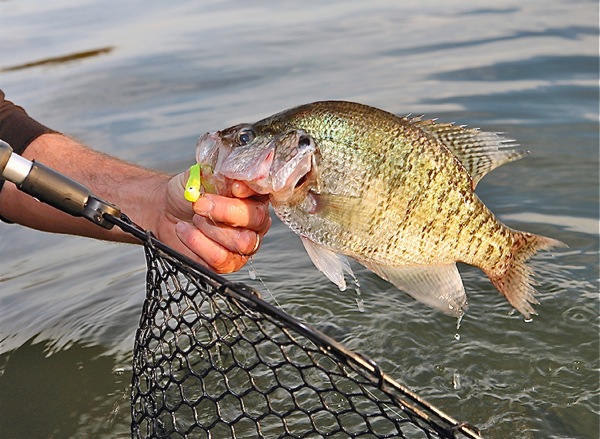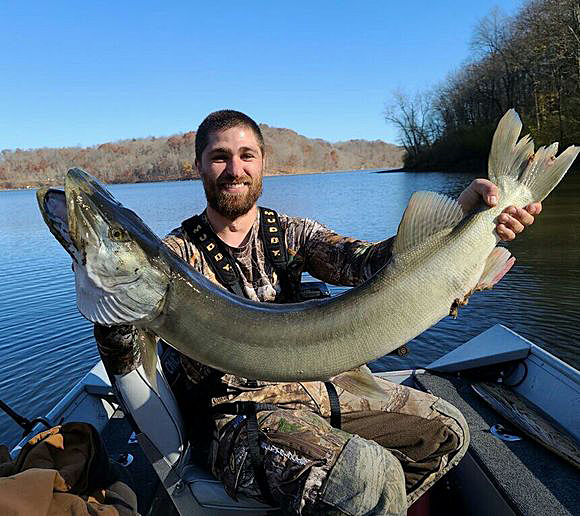
What we’re talking about…Do your homework, be patient, and fish where others won’t…and you can catch better crappies like this one. (Photo by Author)
It’s the most fun you can have in Ohio during March/April with a fishing rod and a bait bucket. Get out and catch yourself a mess of ‘slabs’.
By Ray Reilly for Press Pros
 I was visiting friends in Cambridge a couple of weeks ago, during that warm spell, when a friend called during morning coffee and asked, “Why don’t we go to Salt Fork and catch a bunch of crappies?”
I was visiting friends in Cambridge a couple of weeks ago, during that warm spell, when a friend called during morning coffee and asked, “Why don’t we go to Salt Fork and catch a bunch of crappies?”
“They’re sizing up nice,” he added. “Shouldn’t take more than a couple of hours. Want me to pick you up?”
He didn’t have to ask twice, because it had been on my mind since February…how soon can you get on spring water and catch crappies? In my mind, they’re the most fun you can have with a rod and reel and a bait bucket, and despite all you read and hear about jigs and lures…my favorite way of catching them is still the way I learned growing up. You hook a minnow you seine out of the creek and drop it about three feet deep with a float bobber around a brush pile or submerged log. Do that in March, and you’re going to catch crappies.
It’s about a twenty minute drive from Cambridge to Salt Fork Lake, and after a quick stop at a local gas station/bait shop to buy four dozen ‘fatheads’ we launched just after 10 am. Dale Metzger knows his crappies, knows Salt Fork, and immediately headed for a spot he’d fished for years…a steep dropoff at the edge of a large oak that the wind took down sometime back.
“Not many people come off the main lake this far,” he explained as he tied to a limb sticking up out of the water. “We’re going to fish deeper than most people would, right at the edge of this dropoff. And we’re going to catch some nice ones.”

Coverage of the outdoors on Press Pros is proudly sponsored by Olde English Outfitters, in Tipp City.
Within five minute we were set up, fishing on both ends of the Dale’s boat, and on my first cast with minnow, an eighth-ounce weight, and a red and white bobber it went suddenly down and off at an angle.
“That fish is in ten, fifteen feet of water,” Dale advised. “Don’t be in a hurry. Work him up gently so he doesn’t spook and get you snagged. That’s a nice one, I’d bet.”
Thirty seconds later I had that fish boatside, fifteen inches if it was five, the first of the day.
“Don’t admire it too much,” Dale laughed. “We want about twenty more of those.”
Dale was fishing with a jig and a small worm combination and it wasn’t but a minute until he was engaged with his own fish. Following his own advice, he kept steady pressure on it until he had worked it up in the water column and within arm’s reach. Smaller than mine, it was still almost twelve inches. By the time he had it strung and we snapped a couple of pictures, I was back in the water and hooked up with another fish.
Like the first one, this one took the minnow and worked its way down into deeper water.
“We’re fishing just above where there’s a bunch of them schooled,” Dale said. “We’re at the perfect depth and what they’re doing is trying to get back to their protection when they feel the pressure of the rod and line.”
 Moments later I had it boatside, an almost identical one the first, maybe a couple inches smaller, but beautifully colored, a perfect specimen of a Black Crappie.
Moments later I had it boatside, an almost identical one the first, maybe a couple inches smaller, but beautifully colored, a perfect specimen of a Black Crappie.
Good fishing never gets monotonous, but I can actually say that for the next hour there wasn’t a time when at least one of us wasn’t hooked up. And there wasn’t one of the twenty fish we ultimately kept that was under a foot in length. The minimum length is nine inches, and we were nowhere near that size. The daily bag limit is thirty fish at Salt Fork.
By noon we had a select catch of fish, we released what we didn’t want to clean, and were back in the truck and headed for town. I’ve always believed that Salt Fork was one of the best crappie waters in Ohio if you knew your stuff. And I say that because a lot of people over the years have claimed it’s fished out, struggling to reach the nine-inch limit. But in fact, it’s a big lake and those who complain are the same that fish the easy waters day after day, leaving a lot of better fish to die of old age because they’re not prepared to explore and experiment in deeper, unfamiliar water.
If you want to, that same technique works on just about every waterway you can name in Ohio. And in Press Pros country that includes Lake Loramie and Grand Lake to the north, and Cowan and Deer Creek to the south and east.
And one more thing…the best-eating fish are caught in water before it gets to 40 degrees. Get there now while the eatin’s good.
‘Til next time…I’ve enjoyed it.


